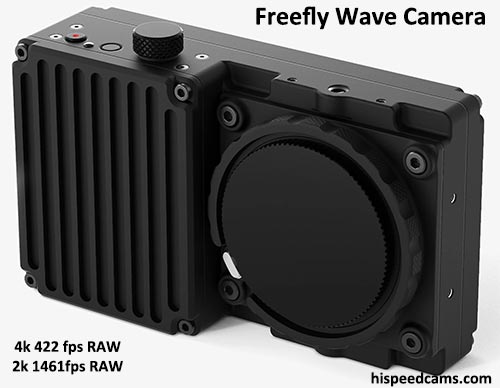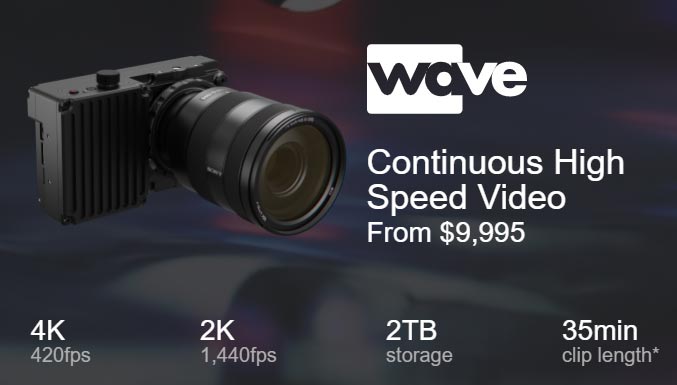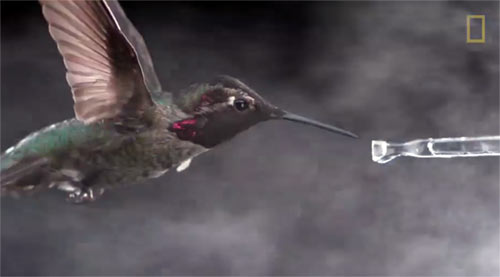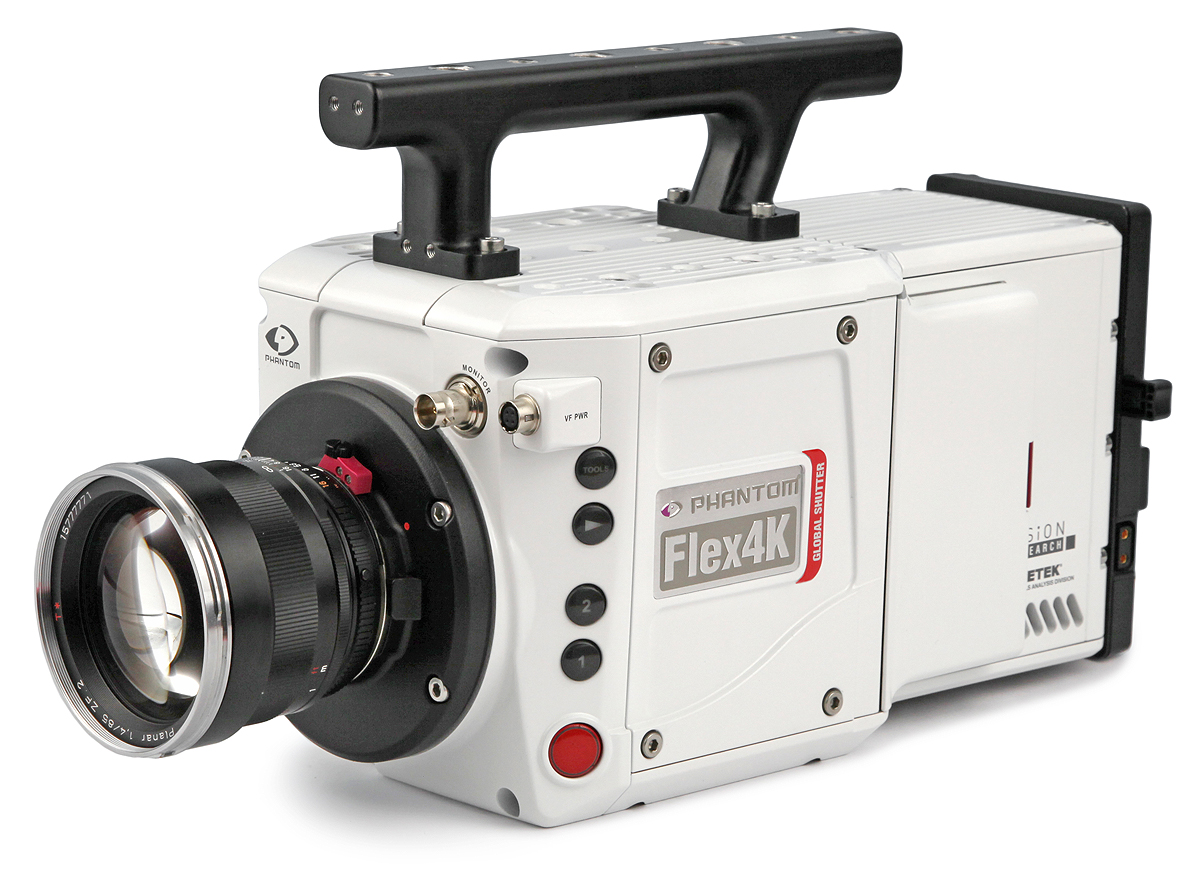Our of our readers Chinito Pinoy has shared a pretty remarkable video with us that we would like to share. It is upscaling of sub HD resolution high-speed video at 240p, 480p and 960p from the Sony RX10 IV at 480 and 960fps and the A7S Mark III at 240fps from Sub HD to 4k UHD.
Tag Archives: 4k 1000fps
Freefly Wave Camera Sold Out, Batch 4 Preorders now Available!
It seems Freefly systems completely misjudged the demand for their new RAW 4k Slow Motion camera as the first 100 cameras ordered in batch 1 to batch 3 have all sold out. Now they aim to produce an unspecified number going forward with Batch 4 which is expected sometime in Q2 2021. The popularity of a product like this speaks volumes of the interest in slow-motion for video production, especially at 4k. While the camera is not cheap at $9,995, it is still a bargain considering other options.
You would still need to factor in a field monitor as the camera does not have a built-in screen in the overall cost but these have lowered in value due to competition and wide availability ina variety of sizes and specs. Freefly has also released a few more videos showing the Wave in action which are frankly inspiring and show what the camera is really capable of doing. It seems this camera has been received so well by the market that we are sure Freefly is thinking already about an even higher spec camera for the future, maybe one with 1000fps in 4k.
Freefly Wave Camera Sold Out But More Are Coming in 2021!
Batch 1
- 20 Units (sold out)
- Shipping starts 11/18/2020
Batch 2
- 30 Units (sold out)
- Shipping starts 12/1/2020
Batch 3
- 50 units (sold out)
- Shipping starts 2/15/2021
Batch 4 and beyond (PREORDER HERE)
- Expected to start shipping Q2, 2021
Freefly Wave Camera Sold Out: As you can see the camera’s first three batched sold out in a couple of weeks. For a slow motion camera of nearly 10k USD that is very popular. The camera software is still in beta and the time to shipping should improve on that. We found some noise issues in the shadows that could be improved but other than that the camera was pretty solid from the samples we saw.
Footage of the Wave in Action:
Here are footage samples of the camera in action. Of note is that dynamic range is not as good as the best cameras out there but 11 stops are still respectable considering high speed CMOS Sensors tend to lower dynamic range when using a global shutter which is needed for high speed imaging.
Introducing Freefly Wave – High Speed Camera by Freefly Systems:
Wave 4K 420fps Bandsaw by Shane Colton:
Wave Camera 4k Slow Motion Released for 10k USD!
The Freefly systems Wave camera has been released and it is certainly a market disruptor. It is not your average high speed camera since it is essentially using an internal SSD M.2 card to continuously record slow motion events it functions more as a live capture device than a shot by shot trigger traditional slow motion camera. This is essentially the idea behind the fps1000 camera line by Graham Rowan which sadly was dissolved last year. A new way of capturing high speed by leveraging the speed of SSD flash storage with ultra-high frame rates.
The Wave is no slouch in specs with a 4k spec of 420fps which is not as good as the Phantom Flex 4k which records 1000fps but costs a whopping 160k USD. The Wave costs $9,995 and using an E-Mount with no power or AF functions, can be adapted to a variety of lens systems because of the plethora of adapters that can be used due to the short flange distance. We take a look at the wave specs and why it may be the camera you were waiting for – if you can get one!
Wave Camera 4k Slow Motion Specs:
Continuous Capture Time:
- 4096 x 2176, 422fps, 1TB 19min
- 4096 x 2176, 422fps, 2TB 39min
- 2048 x 1088, 1461fps, 1TB 23min
- 2048 x 188, 1461fps, 2TB 45min
The camera uses a 4:3 aspect ratio from the sensor which is kind of odd but allows for a variety of frame sizes including anamorphic capture if stretch in post. This seems to be an ideal camera for Anamorphic slow motion. Of note is that the Krontech Chronos 2.1 HD is also using a 4:3 sensor which in theory can be used with Anamorphic glass.
Wave Camera by Freefly Systems 4k 1000fps for 10k?
ChrisVTV a filmmaker from Portland Oregon and fabulous slow motion professional has hinted at the existence of a new camera by the makers of the Movi stabilizer, and Astro drones is said to be launching soon at a price about $10,000 USD and could go head to head with Vision Research’s Phantom Flex 4k. There is no specific information other than it seems to be a 4k camera capable of high frame rates, possibly 1000fps.
Since this is a rumor please take it with a grain of salt but it sure seems to be legit. A camera that really de-thrones the Phantom or at least competes with it head to head at less than 1/10th the price will be an explosion in the world of high frame rate camera options. We may be close to having an option that shoots cinema-quality footage for a fraction of the cost in UHD at 4k!
Wave Camera by Freefly Systems 4k Post:
You an visit Chrisvtv’s Instagram feed here!
Also, you can visit Freefly systems but it does not show any info on Wave as of yet!
Hummingbird Science Hi Speed on Nat Geo!
The National Geographic Channel in conjunction with Clark lab at US Riverside, Dudley lab at UC Berkeley, have posted a video that shows the process of capturing hummingbirds in flight, feeding, and doing acrobatics all in glorious 4k at 2000fps. It is probably the most scientifically worthy portrayal of hummingbirds in flight ever to be documented.
The intricacies of flight, hovering and coping with the environmental elements that hummingbirds have to fend off and how they accomplish it are now being deciphered with the help of 4k Phantom Flex cameras in great detail mainly shot by naturalist filmmaker Anand Varma. This is all part of a recent National Geographic story on hummingbirds here!
Of note is that the video claims might be inaccurate and only be shot at 1000fps which is the maximum frame rate of the Phantom Flex 4k camera. The video claims 2000fps at 4k which is probably a typo.
Footage Information by Nat Geo and the Scientists:
Once, high-speed cameras were ungainly contraptions, difficult to operate and lug into the field. Now they can fit in a large pocket and are as essential to hummingbird biologists as binoculars are. The sheer magnitude of information captured by these cameras can be hard to fathom.
The first attempt to analyze hummingbird flight is believed to have occurred in Nazi Germany in the late 1930s. Two German ornithologists secured a camera capable of recording 1,500 frames a second. “The regime was developing the first helicopters,” says Karl Schuchmann, former curator of birds at the Alexander Koenig Zoological Research Museum in Bonn. “They wanted to know how birds could hover on the spot.”
In the United States, Crawford Greenewalt had served science on the opposite side of the war effort. A dozen years after the German ornithologists published, Greenewalt picked up the thread of their investigation. His wife, Margaretta, had become interested in bird-watching, and from her, Greenewalt caught what he called “hummingbird fever.” His hummingbird photographs were first published in the November 1960 issue of National Geographic.
Today, Anand Varma continues this legacy by filming hummingbirds like never before: with a 4K camera that is capable of capturing the bird at 3000 frames per second. This behind the scenes video gives a sneak peak into Varma’s process and passion. To read the entire July 2017 article on hummingbirds, click here.
You can see the video here at Nat Geo’s Site:
What It Takes to Film Hummingbirds in Slow Motion:
http://video.nationalgeographic.com/video/magazine/170706-ngm-hummingbirds-behind-the-scenes-anand-varma
This video was based on research done by Clark lab at US Riverside, Dudley lab at UC Berkeley, and the Altshuler lab at the University of British Colombia. The photographer would also like to thank Victor Ortega-Jimenez, Katie Johnson, Sean Wilcox, David Rankin, Nicholas Donnelly, and Tom Adams. Learn more about photographer Anand Varma and his work here.
Here is one more video from the series that you may be interested in:
See Hummingbirds Fly, Shake, Drink in Amazing Slow Motion Video http://video.nationalgeographic.com/video/magazine/170706-hummingbirds-anand-varma-slow-motion
Phantom Flex4K-GS Introduces Global Shutter!
The Phantom Flex 4k camera has made a big splash in TV, Film and Youtube with it’s amazing 4k resolution at 1000fps with a large S35mm sensor. However the first iteration of the camera only had a very fast reading; but in the end a rolling shutter sensor. This made the camera an option for visual recording only; leaving scientific research at 4k out of the realm of the camera due to distortion.
That changes today with the Phantom Flex4k-GS which offers the option to use the sensor in both rolling shutter and Global Shutter mode which is a first on a camera of this resolution. Now scientists can use the resolution prowess of the camera to examine minute detail that needs extreme speeds to be recorded.
Phantom Flex4K-GS Main Specs:
- 9.4 Megapixel resolution
- S35 Sensor 27.6 mm x 15.5 mm – 31.7mm diagonal
- 4K at up to 1,000 fps
- 2048 x 1080 max speed is 1977 fps
- Super-16mm windowed format at 1920 x 1080
- Global Shutter (GS), Switchable to Rolling Shutter (RS)
- Global Shutter (GS): Base ISO 640T Color; 5000T Mono
- Recommended ISO range GS mode: 1000-1600 Color; 10,000 – 20,000 Monochrome
- 6.75 µm pixel size / 12-bit pixel depth
- 8 Giga Pixels/second
- Full featured on-Camera Control Menu
- CineMag IV Compatible
- Choose between Raw and Compressed Recording Formats
- 10 seconds at 1000 fps, 4096 x 2160 resolution and into 128 GB of internal memory
- 2TB CineMag IV holds 2 hours of 4K Cine raw playback at 24p
- 2TB CineMag IV holds over 4 hours of 4K ProRes HQ playback at 30
- Cine raw and Apple ProRes 422 HQ CineMag recording
- PCC Cine file conversion to: Cine Compressed, Cine RAW, AVI, h.264 mp4, Apple ProRes .mov, Multipage TIFF, MXF PAL, MXF NTSC, Uncompressed QuickTime, Windows BMP, OS/2 BMP, PCX, TGA, TIFF, LEAD, JPEG, JTIF, RAW, DNG, DPX
One Impressive State of the Art Camera:
One thing you can clearly see is that this camera is not only unique but in a class appart. At 8 Gigapixels/sec it is eclipsing other similar cameras by several orders of magnitude. Samsung’s recent anouncement of the Exynos 9 8895 has a maximum 1 GPixel bandwidth so effectively 7 times slower than the new Phantom Flex 4k-GS.
The cost is not mentioned but by going by the original Phantom 4k which doing a quick search on Google says $110k starting price. Sure far from affordable to the common man and many small production studios. But for scientific labs, enterprise and Youtube slow motion channels it seems like a rig of $150k is a sure possibility. Being cutting edge will be costly but you have to admire the image quality and features the Phantom Flex 4k and GS are capable of.
This camera is better suited for the rental market and even then it is far from cheap. Prices quoted on some sites are: Daily Rental $3500 Weekly Rental $10500. You could get a full featured edgertronic SC2+ for the weekly rental price and get near 5k fps at 720p. However if you are a production house and just need the camera for a day and absolutely require 4k resolution; there is no other game in town.
The examples below are from the original Phantom 4k non GS version for you to see the 4k 1000fps capability.
Phantom Flex4K – “Let me know when you see Fire” by Gregory Wilson:
Scarlet Macaws Phantom Flex 4K 1000fps by Chater Camera:
Phantom Flex4K Creative Painting UltraHD/4K 1000fps by info123pl:
Phantom Flex4K-GS Rundown from Vision Research:
Built upon the Phantom Flex4K cinema camera platform, the Flex4K-GS incorporates a global shutter with its 4K, 9.4 megapixel, 35mm sensor. The camera’s 4K resolution results in the ability to capture sharp, detailed images for enhanced measurements.
At its full 4096 x 2304 resolution the camera is capable of capturing 938 frames per second (fps). At 4K 4096 x 2160 the frame rate goes up to 1,000 fps and at 2K resolution the camera can capture over 1900 fps. The minimum exposure is 5 microseconds.
The main difference between the Flex4K-GS and the original Flex4K is the addition of a global shutter mode. This enables the camera’s use for industrial and scientific applications where a rolling shutter cannot be used due to possible motion artifacts and the progressive scan behavior of each exposure. While rolling shutter cameras typically achieve higher dynamic range and lower noise, the way the electronic shutter integrates can create motion artifacts, making high precision measurements impossible. The Flex4K-GS has the unique ability to switch between global and rolling shutter modes to take advantage of both scenarios.
The camera works with Phantom PCC software or on its own using an integrated control menu. This along with the CineMag IV media lets you customize the best workflow or capture technique based on the subject at hand. The Cine raw format ensures the fastest high-speed capture on set and maximum quality and versatility for post-production. Alternatively, choose Apple ProRes 422 HQ to improve download time, hard drive space and simplify the workflow, while maintaining excellent image quality.
Key Features
- Full resolution 4096 x 2304
- Up to 1,000 fps at 4096 x 2160
- Global shutter (GS) mode, switchable to rolling shutter (RS) mode.
- Phantom CineMag IV recording media (1TB & 2TB)
- Cine Raw and Apple ProRes 422 HQ recording formats at full resolution
- Up to 128GB of internal memory
- Video monitoring: 4x 3G HD-SDI outputs and one additional component viewfinder port.
- Optional Integrated battery mount supporting industry standard batteries
- Lens mount: Interchangeable between Nikon F/G, Canon EF and PL mounts.
- 2x 12V and 2x 24V accessory outputs
What’s in the Box
- Power supply
- Ethernet cable
- Flex4K MiniBOB
- Camera ships in a sturdy Pelican case with custom foam
- Windows-based Phantom PCC software (camera control, image manipulation, download / transcoding)
- User manual
You can read more and get all the pertinent information on the Phantom Felx 4k-GS at the Vision research website here:
https://www.phantomhighspeed.com/Products/Flex4K-Products/Flex4K-GS





